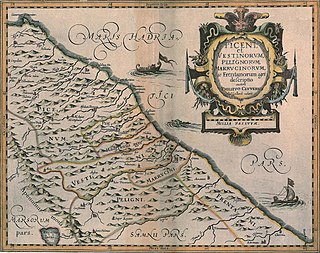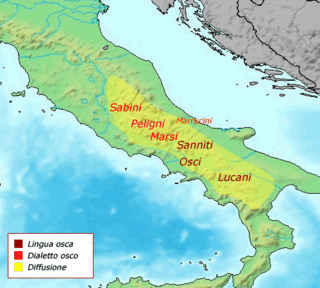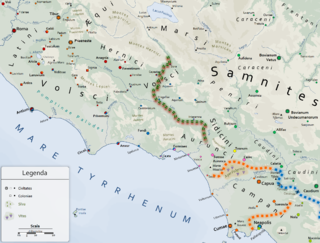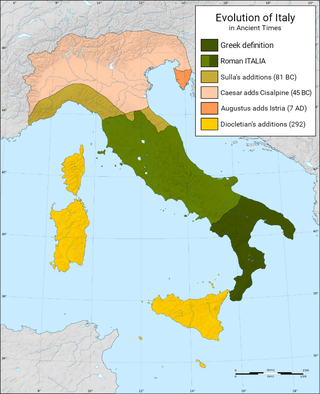Related Research Articles

The Italic languages form a branch of the Indo-European language family, whose earliest known members were spoken on the Italian Peninsula in the first millennium BC. The most important of the ancient languages was Latin, the official language of ancient Rome, which conquered the other Italic peoples before the common era. The other Italic languages became extinct in the first centuries AD as their speakers were assimilated into the Roman Empire and shifted to some form of Latin. Between the third and eighth centuries AD, Vulgar Latin diversified into the Romance languages, which are the only Italic languages natively spoken today, while Literary Latin also survived.

The Sabines were an Italic people who lived in the central Apennine Mountains of the ancient Italian Peninsula, also inhabiting Latium north of the Anio before the founding of Rome.

The Osci were an Italic people of Campania and Latium adiectum before and during Roman times. They spoke the Oscan language, also spoken by the Samnites of Southern Italy. Although the language of the Samnites was called Oscan, the Samnites were never referred to as Osci, nor were the Osci called Samnites.

Vestini were an Italic tribe who occupied the area of the modern Abruzzo, included between the Gran Sasso and the northern bank of the Aterno river. Their main centres were Pitinum (near modern L'Aquila), Aufinum (Ofena), Peltuinum, Pinna (Penne) and Aternum (Pescara, shared with the Marrucini).
The Paeligni or Peligni were an Italic tribe who lived in the Valle Peligna, in what is now Abruzzo, central Italy.

Samnium is a Latin exonym for a region of Southern Italy anciently inhabited by the Samnites. Their own endonyms were Safinim for the country and Safineis for the people. The language of these endonyms and of the population was the Oscan language. However, not all the Samnites spoke Oscan, and not all the Oscan-speakers lived in Samnium.

The Samnites were an ancient Italic people who lived in Samnium, which is located in modern inland Abruzzo, Molise, and Campania in south-central Italy.
The Bruttians were an ancient Italic people. They inhabited the southern extremity of Italy, from the frontiers of Lucania to the Sicilian Straits and the promontory of Leucopetra. This roughly corresponds to the modern region of Calabria.

Volscian was a Sabellic Italic language, which was spoken by the Volsci and closely related to Oscan and Umbrian.

The Osco-Umbrian, Sabellic or Sabellian languages are an extinct group of Italic languages, the Indo-European languages that were spoken in Central and Southern Italy by the Osco-Umbrians before being replaced by Latin, as the power of Ancient Rome expanded. Their written attestations developed from the middle of the 1st millennium BC to the early centuries of the 1st millennium AD. The languages are known almost exclusively from inscriptions, principally of Oscan and Umbrian, but there are also some Osco-Umbrian loanwords in Latin. Besides the two major branches of Oscan and Umbrian, South Picene may represent a third branch of Sabellic. The whole linguistic Sabellic area, however, might be considered a dialect continuum. Paucity of evidence from most of the "minor dialects" contributes to the difficulty of making these determinations.

The Lucanians were an Italic tribe living in Lucania, in what is now southern Italy, who spoke an Oscan language, a member of the Italic languages. Today, the inhabitants of the Basilicata region are still called Lucani, and so is their dialect.

The Frentani were an Italic tribe occupying the tract on the southeast coast of the Italian peninsula from the Apennines to the Adriatic, and from the frontiers of Apulia to those of the Marrucini. They were bounded on the west by the Samnites, with whom they were closely connected, and from whom they were originally descended. Hence Scylax assigns the whole of this line of coast, from the frontiers of Apulia to those of Picenum, to the Samnites. Their exact limits are less clearly defined, and there is considerable discrepancy in the statements of ancient geographers: Larinum, with its territory, being by some writers termed a city of the Frentani, while the more general opinion included it in Apulia, and thus made the river Tifernus the limit of the two countries. The northern boundary of the Frentani is equally uncertain; both Strabo and Ptolemy concur in fixing it at the river Sagrus, while Pliny extends their limits as far as the Aternus, and, according to Mela, they possessed the mouths both of that river and the Matrinus. The latter statement is certainly inaccurate; and Strabo distinctly tells us that the Marrucini held the right bank of the Aternus down to its mouth, while the Vestini possessed the left bank; hence, the former people must have intervened between the Frentani and the mouth of the Aternus. Pliny's account is, however, nearer the truth than that of Strabo and Ptolemy; for it is certain that Ortona and Anxanum, both of which are situated considerably to the north of the Sagrus, were Frentanian cities. The latter is indeed assigned by Ptolemy to that people, while Strabo also terms Ortona the port or naval station of the Frentani, but erroneously places it to the south of the river Sagrus. Hence, their confines must have approached within a few miles of the Aternus, though without actually abutting upon that river. On the west, they were probably not separated from the Samnites by any well-marked natural boundary, but occupied the lower slopes of the Apennines as well as the hilly country extending from thence to the sea, while the more lofty and central ridges of the mountains were included in Samnium.

"Ausones", the original name and the extant Greek form for the Latin "Aurunci", was a name applied by Greek writers to describe various Italic peoples inhabiting the southern and central regions of Italy. The term was used, specifically, to denote the particular tribe which Livy called the Aurunci, but later it was applied to all Italians, and Ausonia became a poetic term, in Greek and Latin, for Italy itself.
Caudium was the main city of the ancient Caudini tribe in Samnium situated on the Appian Way between Beneventum and Capua, in what is now southern Italy. It was 21 Roman miles from Capua, and 11 from Beneventum. It, or nearby Arpaia, became the seat of an early bishopric, which is now a Latin Catholic titular see.

The etymology of the name of Italy has been the subject of reconstructions by linguists and historians. Considerations extraneous to the specifically linguistic reconstruction of the name have formed a rich corpus of solutions that are either associated with legend or in any case strongly problematic.
The gens Albia was a minor plebeian family at Rome. They were of senatorial rank during the latter part of the Republic, but the only of this gens who obtained the consulship was Lucius Albius Pullaienus Pollio, in AD 90. Other Albii are known from various parts of Italy.

Ver sacrum is a religious practice of ancient Italic peoples, especially the Sabelli and their offshoot Samnites, concerning the deduction of colonies. It was of special interest to Georges Dumézil, according to whom the ver sacrum perpetuated prehistoric migration practices of Indo-Europeans to the end of the Iron Age and into the beginnings of history, when stable sedentary dwelling conditions had already become general.
The Sidicini were one of the Italic peoples of ancient Italy. Their territory extended northward from their capital, Teanum Sidicinum, along the valley of the Liri river up to Fregellae, covering around 3,000 square kilometres in total. They were neighbors of the Samnites and Campanians, and allies of the Ausones and Aurunci. Their language was a part of the Osco-Umbrian linguistic family.
The gens Pacidia was an obscure plebeian or patrician family at ancient Rome. Few members of this gens are mentioned by the historians, but a number are known from inscriptions. The most notable may have been the two Pacidii who were commanders in the army of Gnaeus Pompeius Magnus during the Civil War.
References
- ↑ Barthold Georg Niebuhr (1831). The History of Rome. J. Smith. pp. 90–.
- ↑ Smith, William. Dictionary of Greek and Roman Geography . London: John Murray. p. 91.
- ↑ Plin. H.N., iii. 12. §. 17
- ↑ Strabo, volume v.
- ↑ Liv. viii. 1, x. 19
- ↑ Virg. G. ii. 167, Aen. vii. 665; Hor. Carm. iii. 6. 37; Juv. iii. 169.
- ↑ Giacomo Devoto, Gli Antichi Italici, Firenze, Vallecchi, 1931, p.103
- ↑ Antonio Manzo, Dall’etnico safīno ai samnītes, in Annuario ASMV 2001, pp. 193-197, 2002.
- ↑ "LacusCurtius • Strabo's Geography — Book V Chapter 3".